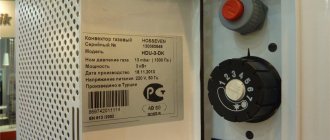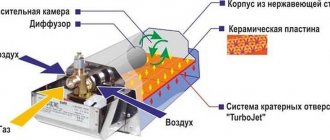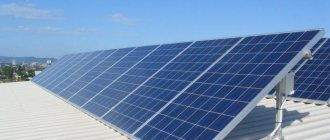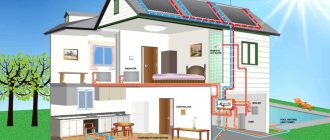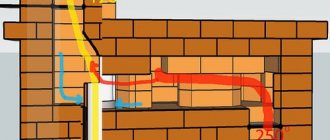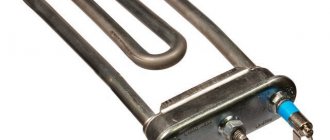Device, principle of operation
The purpose of the heating unit is to transfer heat to the surrounding space. In the combustion chamber of a gas convector, natural gas burns, heating the heat exchanger, which, in turn, transfers heat to the surrounding space. The principle of heat transfer is based on convection - the natural mixing of gaseous substances with different densities. Gaseous fuel, when burned, transfers thermal energy to the finned heat exchanger. The air, in contact with the surface of the heated metal, heats up and rises, making room for a new portion of cold air.
Which chamber to choose a convector with?
In standard convectors, gas burns in an open chamber, and combustion products are discharged through a chimney, which causes significant inconvenience. Installing a chimney passing through the floors and roof is not an easy task and incurs additional costs. The advantage is lower cost.
Modern gas heaters are often equipped with closed chambers. In them, combustion products are released and air is taken in through a special chimney, consisting of two pipes of different diameters inserted into each other. This gas outlet is much easier to install and more practical.
Gas convector - front view
Structural diagram
The concept of a gas convector is based on the combustion of fuel, which forms a combustible mixture, mixing with air in a gas burner and transferring heat from the heat exchanger to the surrounding air.
Common heater elements:
- A housing that combines component units.
- Gas-burner.
- The combustion chamber.
- Heat exchanger.
- Control system.
Gas heating convectors differ from each other in thermal power, types of combustion chambers, heat exchanger design and monitoring and control mechanism.
Properties
Gas convectors running on natural gas are autonomous heat sources. Some models require a connection to the electrical network for the operation of the control and smoke removal system.
Advantages
- Full autonomy - for convectors with a mechanical control system running on imported liquefied gas.
- Compact dimensions, especially for wall-mounted options. The device does not take up much space and fits organically into the interior of the room.
- The possibility of making the body in a variety of design solutions, for example, in the form of a floor-standing fireplace.
- There is no risk of the system defrosting - no coolant is used in the heating circuit. Ability to start at -50°C.
- The convector is beneficial for periodic use during temporary stays of people. This work schedule is typical for garden houses, dachas, garages, camp sites, etc.
- Operation as a backup heat source for the period of repair work on the main equipment, in case of a temporary loss of electricity or in the event of a break in the supply of main gas.
- The average efficiency of gas convectors is 80-95%. Some models are capable of operating with efficiency up to 97%.
- The economic component allows it to compete with electric analogues.
Flaws
- Uneven heat flow throughout the room. The lowest temperature is at floor level, the highest is near the ceiling. Cold spots form due to furniture.
- The simplest models burn oxygen in a heated room. There is a need for good ventilation.
- Appliances with a closed combustion chamber require the installation of external air supply systems and the construction of a chimney.
- Increased fire and explosion hazard.
- The narrow specialization of the heater is heating the surrounding air, and nothing more. The availability of hot water is provided only by a gas boiler.
- Heating one room. Multiple rooms will require a separate unit or efficient air ventilation.
- Installation becomes more complicated when supplied from the main gas pipeline. The need for the construction of an external chimney.
Residential installation
A gas convector for home heating is safe if the operating rules are followed. The danger comes from the working fluid – natural or liquefied gas. Hence a number of restrictions on installation and operation:
- Convectors with an open combustion type are allowed to be installed in private buildings. Installation in multi-storey buildings is prohibited. It is allowed to use the system in an apartment without an external chimney.
- Structures with any type of combustion are allowed for use in low-rise private housing construction.
- It is allowed to use thermal appliances in industrial and civil premises.
- Preparation of documents for the installation of a separate gas convector is simpler than for a water heating boiler.
In any case, the use of equipment requires approval from the gas service of the locality.
Types of gas convectors
There are two types of gas heating devices used for heating a room: wall-mounted and floor-mounted. Wall-mounted ones are more convenient and are usually hung under the window, creating a thermal curtain between the room and the window. But their weight should not be too large so as not to create an additional high load on the wall. Their power is usually limited to 10 kilowatts.
Work principles
To heat large rooms, powerful floor convectors are used. They are heavy and bulky, so when installing, you must consider the strength of the base on which the equipment will be installed.
This is interesting: The heating is turned on, but the radiators are cold: practical tips for restoring the operation of the heating system
Selection of thermal equipment
A gas convector, like other heating equipment for the home, contains a number of distinctive features - structural, design, economic and others. The choice is influenced by the area of the heated room, the seasonality of operation, the presence or absence of an electrical network, whether main gas is supplied or whether it will be a liquefied fuel. An important factor is the economic component. That is, the cost of the equipment itself plus heating costs. Correct analysis of parameters and properties will help you choose the required design.
type of instalation
Gas convectors are available in two types - wall-mounted or floor-mounted. The first option has lower power, up to 10 kW. It has a compact size and does not take up much space. It's easier to choose a location for installation. Easy installation. The wall-mounted heater will easily fit into the living area and will not disturb the interior of the room. Belongs to the household series.
The floor version is more massive. Power up to 20 kW or more. The external design is more interesting, the design is more complex. Requires a separate chimney and air supply system from the outside of the building. Consumes electricity. Installed on legs. Suitable for industrial buildings and public premises.
Fuel
The convector is designed for operation with natural methane (the main type of fuel) or liquefied gas - propane. For the latter case, a special adapter is provided.
The use of natural gas is advisable if there is an extensive gas network near the equipment installation point. There is no need to periodically change liquefied fuel cylinders. The option is more effective from an economic point of view.
The use of bottled gas means complete autonomy. This type is beneficial for garden houses, on farms, as a temporary form of heating for the housing of field construction teams, geologists, and expeditions. The downside is periodic trips to get a new portion of fuel.
Combustion chamber view
Closed or open combustion chambers. The first option involves taking air from the street. There, through a coaxial chimney, combustion products are discharged. The second option is more compact, but uses room oxygen. Plus - the design is simpler and cheaper.
REFERENCE. A coaxial chimney is a structure of two pipes nested inside one another. The external circuit is used to supply and simultaneously heat air from the street. The internal circuit removes combustion products.
Heat exchanger material
Gas combustion occurs at high temperatures, up to 500-700°C. Only steel or cast iron can withstand such heat flows.
Steel construction is lighter, easier to manufacture and cheaper. Cast iron is better able to withstand temperature influences. But the material is more difficult to process, the heat exchanger is heavier. The advantage of a cast iron heat exchanger is that its service life is two to three times longer than that of a steel one, up to 50 years. Minus – the cost is 20-30% higher.
Energy dependence
Simple models running on liquefied gas are completely autonomous, excluding the supply of fuel. Network fuel supply makes the operation of equipment dependent on the supplier.
Adding a fan to the system to quickly warm up the room, control units powered by electricity, tie the heater to external energy sources.
Additional options
Adding technical devices increases the cost of the convector, but adds useful functionality:
- The built-in fan reduces the time it takes to warm up the room. This device will come in handy during the cold season.
- An electric impeller in the system for supplying or removing air and combustion products, respectively, increases the efficiency of the equipment. In addition, forced exhaust increases the safety of the convector.
- Electronic control unit. Links the operation of the convector with the set temperature in the room. The timer automatically starts the burner at the set time of day. The system regulates the gas supply and issues a command to ignite or extinguish based on a signal from a temperature sensor in the room. Increases safety by turning off the gas supply in the event of abnormal combustion conditions or emergency situations.
Power calculation
One of the determining factors when choosing heating equipment. Shows the ability to maintain the required temperature to create a comfortable thermal background in the room.
Approximate figures for determining the required thermal efficiency of the convector:
- 1 kW for heating 25-30 m³ of room volume;
- or ~0.1 kW per 1 m² of area.
That is, to heat a 30 m² room you will need a 3 kW convector. In practice, the parameters are set to be 20~30% higher than the nominal ones. This will avoid freezing during severe frosts and will extend the life of the equipment.
Advantages and disadvantages
Convectors operating on gas have a number of advantages:
- compact size and aesthetic appearance, so they can fit perfectly into absolutely any interior;
- high efficiency;
- lower heating costs, because the air is heated directly, and not thanks to the coolant;
- in each individual room you can set a certain temperature, because... heating with convectors does not depend in any way on adjacent rooms;
- quick heating of the room;
- resistance to freezing.
Gas wall convector Alpine Air DT 3000
Disadvantages of gas convectors:
- You can only heat one separate room;
- limited choice of thermal conductivity, in most cases, the power of devices varies from 2 to 7 kW;
- they are not easy to disguise;
- not suitable for heating water.
If you want to install a gas convector in an apartment, then first you need to obtain permission from the gas service.
Installation
The fundamental document for installing heating equipment is the operating instructions included with the product. It provides a description and sequence of installation operations.
Peculiarities
- Wooden house. Thermal insulation of wooden structures is required. It will be necessary to make fire breaks to the roof. The surface of the coaxial chimney heats up slightly due to its design features; there is no need to insulate it.
- Distance from the floor. The minimum distance to the base is no less than 10-15cm. This is necessary for efficient supply of cooled air. Increasing the distance will lead to the formation of a lower cold layer, increasing the temperature under the ceiling.
- Location along the walls. It is limited to the point of external supply of the main pipe for a natural fuel convector and the outlet of the coaxial chimney. The use of a balloon option adds freedom to choose the installation location. It is necessary to take into account the location of people and the location of barriers to heat flow in the form of furniture.
- Connection. Gas pipe laying, wiring and connections are carried out by accredited gas service specialists. The connection to the steel pipe is made with a flexible hose.
- Commissioning activities. The presence of representatives of the local gas service is required. Based on the test results, a note is made in the accompanying documentation for the gas converter.
A gas convector for heating a private house or garage is a successful design for temporary residence of people. An additional function is backup heating equipment.

